Asian markets still have further to fall
While Asia's long-term future is almost certainly bright, markets aren't very good at looking long-term. With earnings set to fall in the short-term, Asia is likely to be in a bear market for some time to come, says Cris Sholto Heaton. But that just means there will be more buying opportunities…

The last few months have been painful for Asian equities. There's nothing mysterious about the sell-off: global markets remain tightly tied to Wall Street and as the US plunged, the rest of the world was bound to follow. But while understandable, it's also irrational.
Nothing in Asia's long-term outlook has changed since October last year, when markets peaked and rolled over. Yet the MSCI Asia ex-Japan index is down 41% from its peak, making Asia one of the worst-performing regions in the world.
I'd like to say this is going to turn around and roar back very soon. But I don't think it is. Conditions will probably be tough well into next year. But as a mostly long-term investor, I'm not too worried about bear markets indeed, there is a good side to sell-offs like this. Let's take a closer look at the situation
MoneyWeek
Subscribe to MoneyWeek today and get your first six magazine issues absolutely FREE

Sign up to Money Morning
Don't miss the latest investment and personal finances news, market analysis, plus money-saving tips with our free twice-daily newsletter
Don't miss the latest investment and personal finances news, market analysis, plus money-saving tips with our free twice-daily newsletter
Brace yourself for weaker earnings
Today, Asia's future is just as it has been for many years extremely bright. Over the next few decades a large number of people will become much wealthier and be able to spend more. Hundreds of millions will come out of poverty and subsistence living and enter the global economy.
Countries such as China will develop enormously, becoming more self-sustaining and less export-driven. All this will mean a major shift in the balance of power and wealth from west to east. In the long-term, Asia is where the opportunities are.
But the market doesn't think long term. It thinks in terms of months maybe a couple of years at best. And the news over the next few months is likely to be gloomy.
That's because what the market cares about most are earnings. There are many different ways to value a company, but in reality all that really matters in the short term is what earnings are doing: are they a) higher than the last time, b) higher than expected and c) set to be higher next time.
And the news on the front isn't great. Like the rest of the world, earnings in Asia are set to disappoint over the next few months. Back in January, consensus forecasts for 2008 had Asian stocks growing earnings at an average of around 10%. Now they're down to around 4%. By the end of the year, there's a good chance that growth will be negative.
What's more, analysts are making the classic mistake of bringing down this year's earnings forecasts while leaving next year's untouched. The result? Apparently, 2009 will see an extremely rapid recovery with earnings rising 16% year-on-year.
That's unlikely to happen. So over the next few months, those 2009 forecasts will be coming down. Since investors don't seem to be awake to this yet, there's a good chance that they'll suffer more disappointment as the downgrades roll in.
Focus on book value, not earnings
So how much lower might Asia markets go if this happens? Let's take the MSCI Asia ex Japan (which I'll call the AxJ from now on) for an overview of the region first, before looking a bit more closely at a few individual countries. As you can see, the AxJ has given back a lot of its bull market gains.
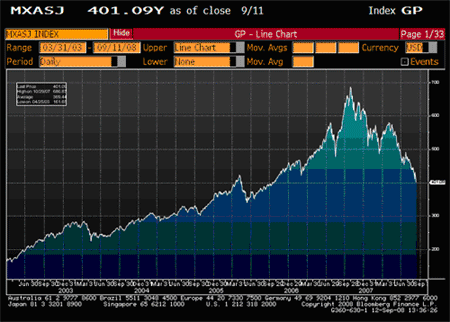
The first thing to bear in mind is that because Asia has sold off so heavily particularly given its long-term prospects we're almost certainly closer to the bottom than the rest of the world. Almost everything is seen as negative for Asian markets, while on Wall Street, for example, there's still a large coterie of deluded optimists that keep the market rallying.
Optimists are already pointing to the price/earnings ratio as a sign the bottom is close: the forward p/e ratio for AxJ is 11.8 and they point out that the index has rarely traded below this. But of course, that depends on earnings. If forecasts are cut further as is likely that p/e ratio would go up. In three months, stocks might not look as if they're on rock bottom valuations any more.
Instead, price/book may be a more useful measure to keep your eye on, since - for most stocks - book value isn't hurt by a downturn and so often puts a useful 'floor' on valuations (book value is the total of a company's assets minus its liabilities). Citigroup analyst Marcus Rosgen points out that the average price/book ratio on the AxJ over the long term is around 1.8 times and right now that's almost exactly where the market stands.
Unfortunately, Asia doesn't seem to spend much time at the average it tends to cycle from under to over. As you can see from the 33-year chart below, once the price/book ratio starts going down, it continues to slide until it's quite a way under the average.
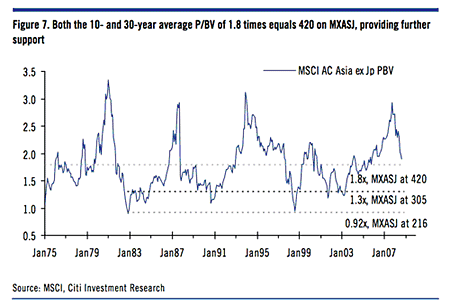
What's more, once price/book bottoms, it tends to mark quite a definite turning point for the market. (The chart below is only 15 years because unfortunately Bloomberg data doesn't go back further than that for the AxJ.)
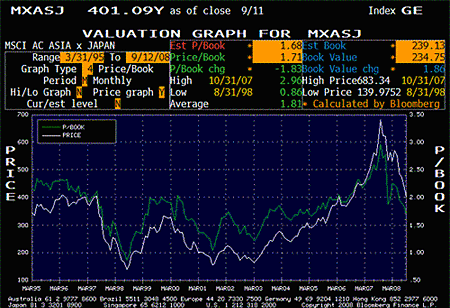
P/B has dipped as low as 0.86 in the past but that was during the Asian financial crisis of 1997/1998. With the region in far, far better financial shape these days, the more typical cycle bottom of 1.1-1.3 times looks to be the lowest level possible and there's a good chance that it could be 1.5 times or better.
A p/b of 1.5 times would put the AxJ at around 350 another 13% down from here. But I doubt we'll get there as quickly as that might suggest. There's good reason to expect a year-end rally, before a final sell-off early next year as the impact of those 2009 earnings downgrades come through.
China's plunge isn't over yet
What about individual markets? The most obvious one to look at is China, where the market continues to plunge. The CSI 300 index is now 64% off its high and back to levels last seen more than a year-and-a-half ago.
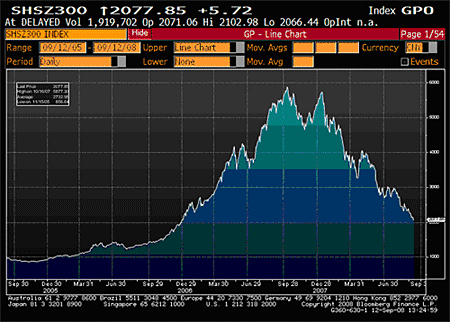
On a p/e ratio of under 15, China is very cheap given its prospects, even if earnings forecasts are cut. But measures like p/es mean nothing in the aftermath of a bursting bubble, where sentiment generally fear reigns supreme.
For that reason, trying to guess how long the market could go on based on fundamentals is a doomed effort. But bearing in mind that bursting bubbles typically give back all their bubble era gains just like Vietnam recently the idea that the market could slide towards 1,000 or so is not impossible.
Once the market reaches its low whenever that is history suggests we may well see quite a rapid rally. This could present a good trading opportunity, to be played through a market tracker or an exchange-traded fund. Unfortunately, there's no ETF that tracks the mainland China indices such as the CSI 300, but there are a number that track the FTSE/Xinhua 25 index of 25 large Chinese stocks, including one from iShares (NYSE:FXI).
Vietnam could buck the trend
For once, China's future is Vietnam's past, as we can see from the chart below. In early June, the index bottomed after falling 69% peak to trough, following by a rapid rebound of around 50%.
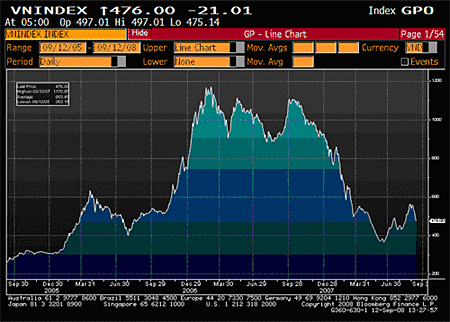
Of all the markets in Asia, Vietnam probably has the best chance of bucking the downward trend over the next few months albeit at high risk and certainly with lots of volatility. It's a small market that isn't a member of regional indices like the AxJ and most big funds aren't invested there, so it isn't likely to be overwhelmed by huge flows of money flowing in and out of the stockmarket.
The main issue is likely to be local sentiment. With the bubble burst over and the economy showing signs of improvement, Vietnam could do surprisingly well in the near term and, as we've noted before, its long-term prospects are excellent. The easiest way of gaining access is via a low-cost, diversified fund - Deutsche Bank's Vietnam Index ETF x-tracker (LON:XFVT) or Aim-listed Vietnam Opportunity Fund (LON:VOF) are the obvious candidates.
India has more risks than the market thinks
On the other hand, India may have more downside risk than many people realise. The Sensex has performed better than most of Asia this year and remains above its lows in mid July. But it still seems to be a downward trend and there are probably more risks than investors seem to think.
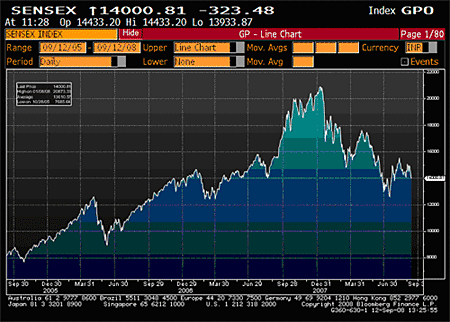
India is a little different to most economies in Asia. Exports are a relatively small part of GDP, while services are more significant and manufacturing less significant than neighbours. What's more, the country isn't really part of the Asian supply chain, in which countries trade exports between each other for further assembly and finishing before final export to the US or Europe. Consequently, domestic demand is more crucial to earnings and the global export slowdown less important.
But earnings forecasts may still be overly optimistic. Analysts expect earnings growth of around 16% this year, down a little from the 20%-plus pace of recent years, but still pretty high. Since the economy is slowing as the central bank raises interest rates in an effort to contain inflation, there's a real risk of disappointment and investors bailing out once it becomes clear that India isn't isolated from the earnings slowdown.
Other Asian markets remain vulnerable - especially Thailand
Elsewhere in Asia, investors are panicking about the prospect of lower export earnings especially with commodities having fallen hard in recent weeks. As a result, markets are likely to continue to slide until earnings downgrades stop coming.
Political problems are adding to pressures as well. Most notable is Thailand, where the ongoing struggle between a government still loyal to exiled ex-prime minister Thaksin Shinawatra and the misnamed People's Alliance for Democracy protest movement which wants to replace democracy with appointed lawmakers shows no sign of a quick resolution.
We'll look at the Thai situation in more detail in a future issue of MoneyWeek Asia. But for now, the chart below tells the story despite cheap-looking valuations, the market has gone nowhere for three years. Until the political situation is resolved, the country is likely to remain a "value trap", as Christopher Wood of CLSA puts it succinctly in the latest issue of Greed and Fear.
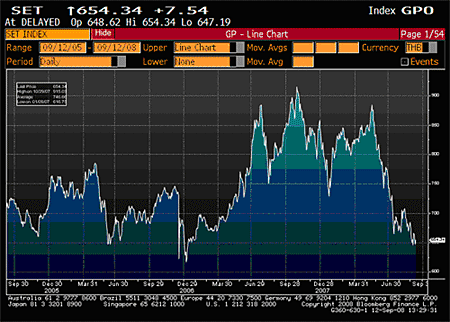
A good time to think long-term
All told, most of Asia is likely to stay in a bear market for quite a few months more. So why might there be any good news in this for investors?
Well, Asia's fundamentals are unchanged and the long-term growth story is intact. Good quality firms will be worth considerably more in a few years' time than they are now. So sell-offs like this are an opportunity to pick up good stocks for long-term portfolios at a cheap price.
Of course, that strategy is very easy to preach, but quite hard to implement. Very few investors can sit there watching their portfolio slide and feel happy about putting more money into the market. Even though any further slide is unlikely to be a big deal in the long-term, it's still painful for now.
For that reason, MoneyWeek Asia's strategy is to look for stocks that operate in reasonable defensive industries, yet still have good growth prospects. That doesn't guarantee your stocks will hold up: our recent pick Ezra Holdings has slid as oil came off even though a) its clients will be budgeting on a $60-$70 a barrel oil price, below current levels b) much of its fleet is already booked on long-term charters giving it earnings stability and c) this information should be well known in the market.
But even so, picking these sorts of stocks reduces the chances of your portfolio turning a disheartening sea of red, which makes it hard to stick to even the best long-term strategy.
The time to buy more cyclical stocks is not yet here. Consider Chinese banks and property developers: both sectors have a bright future and are not expensive on a long-term view, but they're likely to get cheaper still as the Chinese property slowdown gathers speed, as we discussed two weeks ago. Analysts at Morgan Stanley have just put out a research note predicting a "property meltdown" with big losses likely at some banks and developers. Once that kind of fear is widespread in the market, it will be time to jump in. But for now, we prefer to stay cautious.
Get the latest financial news, insights and expert analysis from our award-winning MoneyWeek team, to help you understand what really matters when it comes to your finances.
Cris Sholto Heaton is an investment analyst and writer who has been contributing to MoneyWeek since 2006 and was managing editor of the magazine between 2016 and 2018. He is especially interested in international investing, believing many investors still focus too much on their home markets and that it pays to take advantage of all the opportunities the world offers. He often writes about Asian equities, international income and global asset allocation.
Cris began his career in financial services consultancy at PwC and Lane Clark & Peacock, before an abrupt change of direction into oil, gas and energy at Petroleum Economist and Platts and subsequently into investment research and writing. In addition to his articles for MoneyWeek, he also works with a number of asset managers, consultancies and financial information providers.
He holds the Chartered Financial Analyst designation and the Investment Management Certificate, as well as degrees in finance and mathematics. He has also studied acting, film-making and photography, and strongly suspects that an awareness of what makes a compelling story is just as important for understanding markets as any amount of qualifications.
-
 MoneyWeek news quiz: How much can you win in Premium Bonds?
MoneyWeek news quiz: How much can you win in Premium Bonds?Quiz Premium Bonds, ChatGPT, and the start of the festive season all made headlines this week. How closely were you following the news?
-
 Salary sacrifice pensions cap: 3.3 million workers to be hit by contribution limits
Salary sacrifice pensions cap: 3.3 million workers to be hit by contribution limitsThe government has revealed further details of its controversial cap on pension contributions through salary sacrifice. Here is how the changes could affect you
